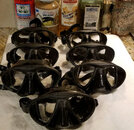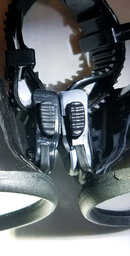- Messages
- 7,659
- Reaction score
- 4,720
- # of dives
- 200 - 499
OK, here are the 'magnificent seven':

These (and a few more of mine) have gone through 'hell in a handbasket' together and survived.
Fresh out of the clear household ammonia soak, headed to the dishwasher (as soon as it is free) for a final clean and dry, box, address, and ship.
Aside: The background in the above pic isn't accidental. I was to talk about something, non diving, that I was passionate about, there it is. -I just couldn't cut the one-breath, no push-off, entire length of pool underwater swim. So no point in volunteering. (passed the fish test <with flying colors> though)

These (and a few more of mine) have gone through 'hell in a handbasket' together and survived.
Fresh out of the clear household ammonia soak, headed to the dishwasher (as soon as it is free) for a final clean and dry, box, address, and ship.
Aside: The background in the above pic isn't accidental. I was to talk about something, non diving, that I was passionate about, there it is. -I just couldn't cut the one-breath, no push-off, entire length of pool underwater swim. So no point in volunteering. (passed the fish test <with flying colors> though)




